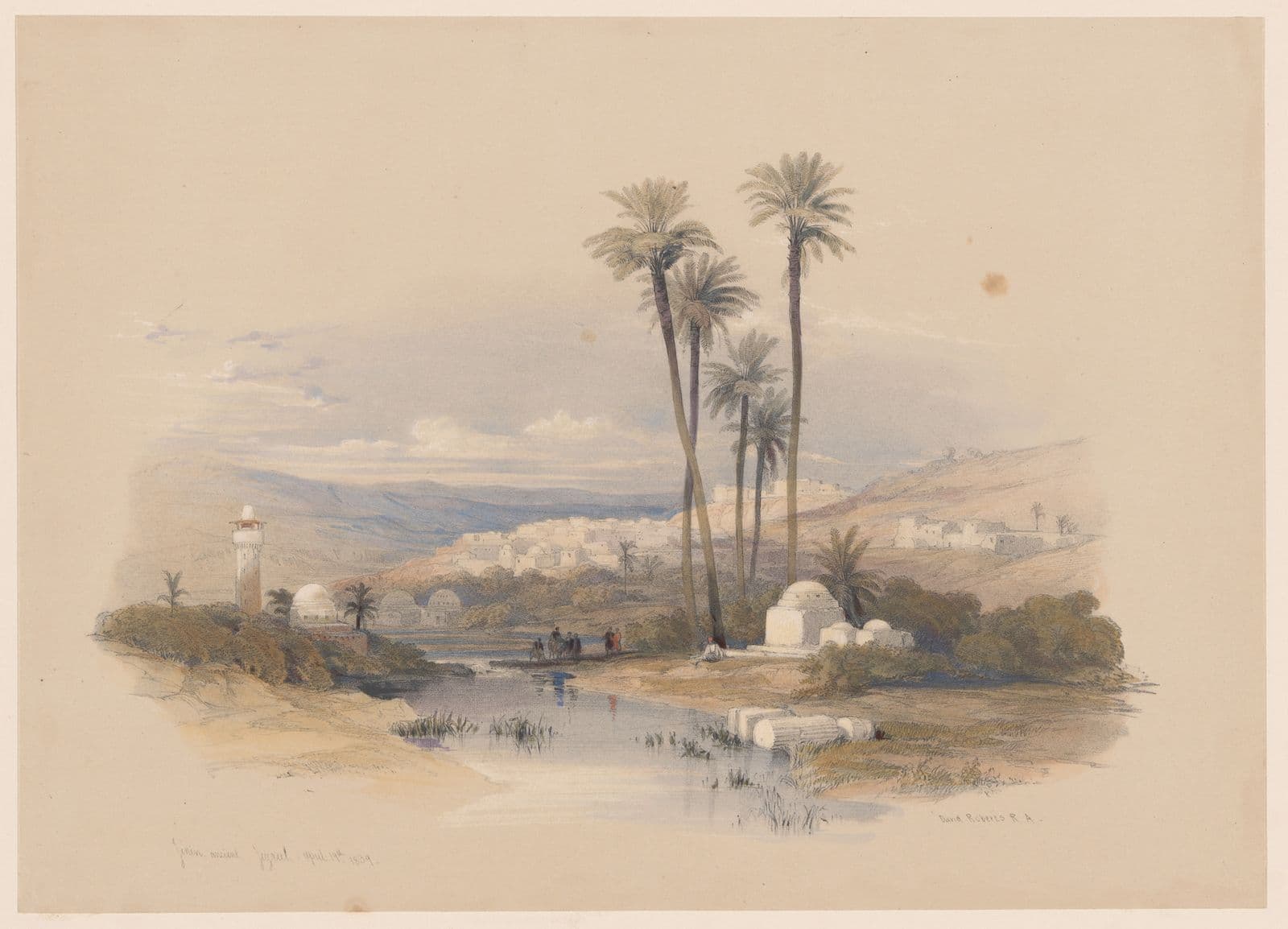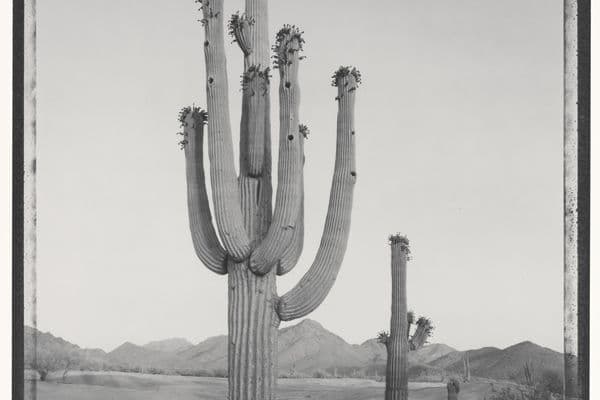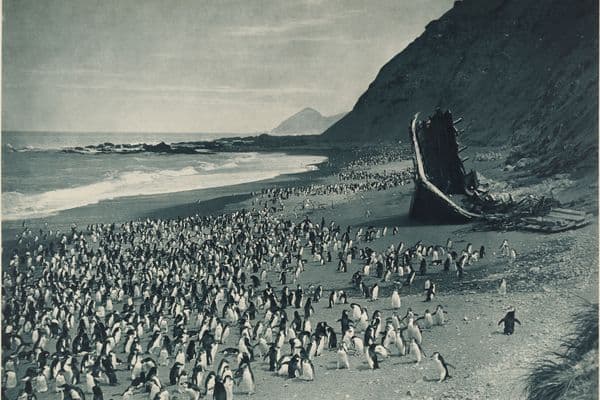Visions of the Orient in the 19th Century
22 Dec 1984 – 3 Mar 1985

David Roberts, Louis Haghe, (Rev) George Croly, F.G. Moon, Jenin, ancient Jezrul, (1843), National Gallery of Australia, Kamberri/Canberra, Felix Man Collection, Special Government Grant 1972.
Exhibition Pamphlet Essay
The idea of the exotic and mysterious Orient acted like a magnet on European artists, writers and scholars in the nineteenth century. The Ottoman Empire extended over a large part of the Orient, which was then taken to encompass the countries of the now Middle East and India, Greece, the Balkans and the Islamic world generally, including North Africa. It is not surprising then that such a large body of Orientalist art should have been produced during the nineteenth century by France and Britain, given the military, political and economic commitments of both countries in various parts of the region.
In 1798 Napoleon Bonaparte led the French army into Egypt, defeating the military caste known as the Mamelukes, depicted in the lithographs of Gros and Géricault. This was the first step in a campaign intended progressively to occupy and 'civilize' the Orient. However, Napoleon's defeat by the British navy under Nelson in the Battle of the Nile made the plan impossible and by 1801 the entire French force had been evacuated. Not until 1830 did France again become a significant power in the Orient through the colonization of Algeria and its neighbouring territories.
Despite the failure of Napoleon's expeditionary force to establish French dominion over the Orient, the venture excited the European imagination. The scholars that Napoleon took with him and the work that resulted from their extensive documentation of Egypt, Description de l'Egypte (Description of Egypt), 1809-29, stimulated interest in the Orient and provided a basis for future exploration. Even more popular in England was Baron Dominique-Vivant Denon's document of Egyptian culture, Voyage dans la basse et la haute Egypte (Travel in lower and upper Egypt), published in London in 1802 as engravings after sketches he made while accompanying Napoleon.
The Napoleonic campaign created a demand in France for images of exotic, heroic subjects, interests that were shared by the Romantic movement which reached its zenith during the period of the Bourbon Restoration, 1814 to 1830. The development of lithography from c.1798 provided a potent force for the dissemination of popular images of this kind. Nicolas-Toussaint Charlet was one of the most prolific exponents of the technique for this purpose. The capacity of lithography for very long printing runs made it comparatively economical and therefore highly desirable. Its unparalleled ability to reproduce the artist's sketch accurately suited the kind of personalised expression aspired to by artists of the Romantic movement in the early part of the nineteenth century.
First-hand knowledge of the Orient was not a prerequisite for the representation of Oriental subjects. For Baron Antoine-Jean Gros, whose epic paintings of heroic deeds made him one of the chief perpetrators of the Napoleonic myth, the Orient provided a major source of inspiration, despite the fact that he had never been there. His Chief of the Mamelukes, depicted as a worthy adversary of the French army, and the lithograph Desert Arab, both of 1817, recall the heroic deeds of the Napoleonic era and conveyed an idealized image of the Orient to the French public.
But the real subject of these lithographs is not the Orient but France itself, as Théodore Géricault's Mameluke, 1818, so dramatically demonstrates. Géricault projects on to the powerful torso of the Mameluke warrior a fantasized image of primitive Oriental strength; a reminder that, for the West, the Orient acted as a kind of surrogate self through which exotic, sensuous fantasies could be vicariously enjoyed. The heroic image of the Mameluke is more suggestive of the preparatory drawings of Negro bodies that Géricault was making around this time for his most famous painting, The Raft of the Medusa, than it is of an Oriental reality.
The Napoleonic invasion of Egypt led to a decline in the power of the Ottoman Empire and growing conflicts in the Orient served as a pretext for continuous intervention by the European powers. Although British interests were nominally confined to India, until the occupation of Egypt in 1882, there was considerable interest in ensuring the stability of the Ottoman Empire in order to protect the vital trade routes to the Indian sub-continent. Britain, therefore, provided a conspicuous military presence in various parts of the Orient and British commercial interests were very much involved with the so-called Overland Route to India.
In Britain, as in France, a fantasized popular Orientalism represented the Orient in the early nineteenth century. Intense British interest in the campaign against the French in the East led to the use of Oriental themes in popular entertainment and to the proliferation of books with illustrations of Oriental subjects. But a number of causes contributed to a growing demand for more realistic representations of the Orient: increasing travel to the East, facilitated by the steamship from the 1830s and the opening of the Overland Route (actually a journey mostly by sea via Suez); the growth in scientific documentation and exploration characteristic of the era; and the increasing religiosity of Victorian England, for those who could not make the pilgrimmage wanted to know what the Holy Land looked like.
The demand for more accurate topographical depictions of the Orient was, of course, to be increasingly fulfilled by photography. In 1838, however, the artist David Roberts could feel confident of an assured market for the output from his travels to Egypt and Palestine in 1838-39. The sketches from his journey were published to resounding acclaim in London as six volumes of lithographs, The Holy Land, Syria, Idumea, Arabia, Egypt and Nubia, from 1842-49. While Roberts sought objective, scientific accuracy in his delineations of antiquarian sites in the Orient, the artist David Wilkie visited Turkey, Palestine and Alexandria in 1840-41 with the express purpose of gathering material for a series of religious paintings. Wilkie died on the voyage back to England and the paintings were never completed, but his sketches were lithographed by Joseph Nash and published as Sketches in Turkey, Syria and Egypt in 1843.
If these works by Roberts and Wilkie were the result of comparatively brief encounters with the Orient the same could not be said of the Reverend Henry J. Van Lennep's illustrations for the Oriental Album, published as lithographs in New York in 1862. An American citizen, Van Lennep was born in Turkey and spent the greater part of his life as a missionary there and in Asia Minor. American influence in the Orient during the nineteenth century was, for the most part, limited to American Presbyterian missionaries who established schools and the American University in Beirut in 1866.
The works of Roberts, Wilkie and Van Lennep purport to a disinterested, scientific objectivity in pictorially documenting the topography, architecture, people and customs of various parts of the Orient, albeit within the prevailing pictorial conventions. But what is noticeable is the absence of history and the absence of a Western presence. We are presented with a vision of a timeless and picturesque world in which people, customs and countries appear unchanged by history or by a material European presence. Roberts was well aware of the significance of this presence when he surveyed the Nile in 1838 and asked the rhetorical question, 'Will this desert ever again become the busy haunt of men? Nothing is more probable, as Egypt is the medium of our direct intercourse with India.'
For Wilkie, the Orient has meaning only as the location of Christianity. For Roberts, Islam is continually weighed in the balance and found wanting. The inhabitants of the various regions in The Holy Land are depicted lying around aimlessly while the remnants of once-great civilizations continue to decay around them. The letterpress text accompanying the images provides further evidence of the degeneracy and corruption of Islamic culture, enthusiastically endorsed by the Biblical scholar Edward Robinson in his expression of regret at the remains of Baalbec, 'that such proud relics of genius should be in the hands of a people incapable of appreciating their merits; and consequently heedless of their complete destruction.’ The Orient represented the ‘other’ in terms of European values and morality, reinforcing the notion of Western supremacy over a backward, inferior civilization and its people.
Nineteenth-century visions of the Orient also extended to the decorative arts. A major contributor to the spread of interest in Oriental decoration was the architect, designer, illustrator, lithographer, painters and writer Owen Jones. He was the first serious student in Europe of Islamic architecture and decorative art and one of a group of vocal design reformers in Britain around the middle of the nineteenth century. Jones’s work was critically concerned with the creation of a new style which reflected contemporary culture and society by appropriating principles and elements of Oriental architecture and decoration and incorporating them into the latest developments in science and technology. His colour scheme for the Crystal Palace at the Great Exhibition of 1851, the watershed of British design reform, and his designs for the Alhambra and Egyptian courts in the Crystal Palace at its subsequent home at Sydenham, indeed all his work including wallpapers, books, textiles, and his architecture, reflect these concerns.
In 1831, Owen Jones set off from London for the Orient, meeting up with friend and fellow architect Jules Goury in Egypt. Together they travelled around Egypt, Syria (which in the nineteenth century referred to the whole of the Arabian Peninsula including Iraq, Jordan, Israel, Lebanon and Syria) and Turkey, sketching the scenery and making a careful study of the architecture in the countries they visited. After Turkey they visited Spain and spent six months making detailed drawings of the magnificent Moorish palace in Granada, the Alhambra. Goury contracted cholera and died in Granada and Jones returned to London in 1834. The results of their study of the Alhambra were published as Plans, elevations, sections and details of the Alhambra, 1842-45.
What attracted Jones and Goury to the study of Islamic and Egyptian architecture and decoration was not primarily structure but colour, or rather the remaining evidence of it. Jones was to say later that he saw Egypt ‘glowing with primary colours’. The intense colour of the East was a major, expressive element in Romantic art, associated with ideas of the sensuality and general exoticism of the Orient. One of the most important factors contributing to Jones’s interest in colour was recent archaeological research uncovering the polychromy of classical buildings.
When Jones returned to London in 1834 he wanted to make Moorish designs known in order to help establish a new style of architecture and design. It was not until 1851, however, that he began to articulate what he considered to be the essential principles to be derived from Oriental architecture. They concerned fitness, propriety, harmony of structure and colour and the repose which they could engender. Harmony of form was based on geometric construction and conventional representation should be founded on natural objects, as in Egyptian and Moorish architecture. These principles were later expanded and consolidated in The Grammar of Ornament, 1856, the most influential book on design in the nineteenth century. The Grammar gave rise to many similar publications such as Auguste Racinet’s Polychromatic Ornament, 1873.
As colour was such a vital factor in both Moorish and Egyptian architecture it was obviously important that the drawings for the Alhambra be reproduced in colour. But Jones was unable to find a printer who could tackle the very difficult work required. With the help of the printing firm of Day and Haghe he set up his own lithographic press and began printing the plates in 1836. This made him one of the earliest printers of colour lithography in England.
The Alhambra was a remarkable publication in several respects. First, for the sheer technical feat of printing such a complex work in colour (it took seven years to complete). Second, it was an important factor in the acceptance of architectural polychromy, not only because it showed coloured architecture but also because it paved the way for cheaper colour printing in England. Third, it enabled a new kind of book illustration, notably in the illuminated gift book. Finally, it identified Owen Jones as a fully-fledged Orientalist. The Alhambra was, effectively, representing Oriental architecture to the West.
The Alhambra proved to be a commercial failure, but the consequence of its failure was the creation of a new industry. Having set up his large and costly printing establishment, Jones was forced to take on other colour printing jobs. One of these involved printing several pages and designing a new edition of Ancient Spanish ballads, 1842. And so the illuminated gift book was born with its decorative title-pages, as well as decoration in the body of the text, very obviously derived from elements in Moorish architecture. The production of illustrated editions had been increasing since the late eighteenth century but in Ballads lithography increased the possibilities for illustration to surround and accompany the text.
The precedents for the illuminated gift book were obviously not in Oriental architecture but in medieval manuscripts, interest in which was a by-product of the Gothic Revival. Jones's experiments in colour lithographic printing provided the impetus for nineteenth-century versions of illuminated manuscripts, sometimes with a text from the Bible on a page surrounded by quasi-medieval decorations complete with Gothic, gilded lettering. But the term 'illuminated gift book' also applied to any book where the illustration and text were combined. Illumination became a popular pastime in the nineteenth century and books of outlines for illumination, as well as manuals and boxes of the requisite colours, complete with brushes and burnishing tools, proliferated.
Jones was involved in every facet of the production of the illuminated book, as designer, illustrator, illuminator and printer and despite occasional reference to medieval sources his designs are essentially dependent, in varying degrees, on Oriental decorative elements. Edward Bateman (1816-1897), an assistant of Jones who, among other things, lithographed Jones's designs for Winged Thoughts, 1851, was in Australia from 1852 to 1867. Among the most notable of his designs in this country were those for the Fitz Roy and Carlton squares in Melbourne; designs strongly influenced by principles of Oriental decoration.
Some of Jones's designs for illuminated books obviously derive from Oriental precedents, such as Ballads and Paradise and the Peri, 1860, the latter partly from Persian Manuscripts. But in much of his work, such as Gray's Elegy, 1846, and The Song of Songs, 1849, it is difficult to isolate the Oriental elements from those based largely on Western culture. Jones effectively appropriated and absorbed elements of Oriental culture into the quintessentially Victorian (and Christian) framework of the illuminated gift book. For the West, it was not the Orient itself that mattered but its use in Western culture.
Text sourced from: Veron, Kay. Visions of the Orient in the Nineteenth Century : Gallery 11A, 22 December 1984 to 3 March 1985 / Australian National Gallery. Canberra: Australian National Gallery, 1984.











